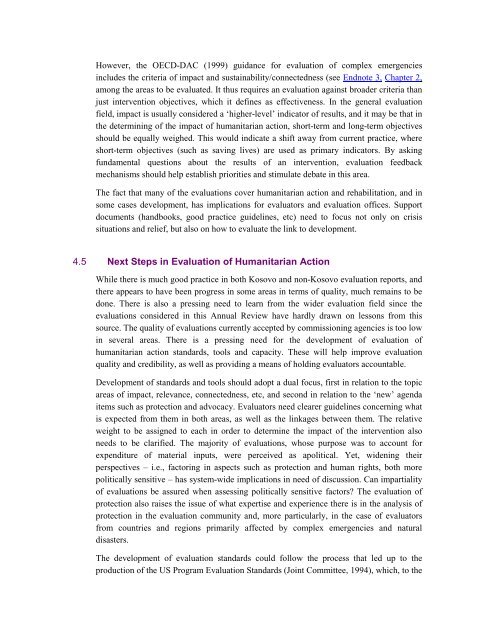Download PDF - ReliefWeb
Download PDF - ReliefWeb
Download PDF - ReliefWeb
Create successful ePaper yourself
Turn your PDF publications into a flip-book with our unique Google optimized e-Paper software.
However, the OECD-DAC (1999) guidance for evaluation of complex emergencies<br />
includes the criteria of impact and sustainability/connectedness (see Endnote 3, Chapter 2,<br />
among the areas to be evaluated. It thus requires an evaluation against broader criteria than<br />
just intervention objectives, which it defines as effectiveness. In the general evaluation<br />
field, impact is usually considered a ‘higher-level’ indicator of results, and it may be that in<br />
the determining of the impact of humanitarian action, short-term and long-term objectives<br />
should be equally weighed. This would indicate a shift away from current practice, where<br />
short-term objectives (such as saving lives) are used as primary indicators. By asking<br />
fundamental questions about the results of an intervention, evaluation feedback<br />
mechanisms should help establish priorities and stimulate debate in this area.<br />
The fact that many of the evaluations cover humanitarian action and rehabilitation, and in<br />
some cases development, has implications for evaluators and evaluation offices. Support<br />
documents (handbooks, good practice guidelines, etc) need to focus not only on crisis<br />
situations and relief, but also on how to evaluate the link to development.<br />
4.5 Next Steps in Evaluation of Humanitarian Action<br />
While there is much good practice in both Kosovo and non-Kosovo evaluation reports, and<br />
there appears to have been progress in some areas in terms of quality, much remains to be<br />
done. There is also a pressing need to learn from the wider evaluation field since the<br />
evaluations considered in this Annual Review have hardly drawn on lessons from this<br />
source. The quality of evaluations currently accepted by commissioning agencies is too low<br />
in several areas. There is a pressing need for the development of evaluation of<br />
humanitarian action standards, tools and capacity. These will help improve evaluation<br />
quality and credibility, as well as providing a means of holding evaluators accountable.<br />
Development of standards and tools should adopt a dual focus, first in relation to the topic<br />
areas of impact, relevance, connectedness, etc, and second in relation to the ‘new’ agenda<br />
items such as protection and advocacy. Evaluators need clearer guidelines concerning what<br />
is expected from them in both areas, as well as the linkages between them. The relative<br />
weight to be assigned to each in order to determine the impact of the intervention also<br />
needs to be clarified. The majority of evaluations, whose purpose was to account for<br />
expenditure of material inputs, were perceived as apolitical. Yet, widening their<br />
perspectives – i.e., factoring in aspects such as protection and human rights, both more<br />
politically sensitive – has system-wide implications in need of discussion. Can impartiality<br />
of evaluations be assured when assessing politically sensitive factors? The evaluation of<br />
protection also raises the issue of what expertise and experience there is in the analysis of<br />
protection in the evaluation community and, more particularly, in the case of evaluators<br />
from countries and regions primarily affected by complex emergencies and natural<br />
disasters.<br />
The development of evaluation standards could follow the process that led up to the<br />
production of the US Program Evaluation Standards (Joint Committee, 1994), which, to the
















![CynefinFramework final [Read-Only]](https://img.yumpu.com/19017304/1/190x135/cynefinframework-final-read-only.jpg?quality=85)